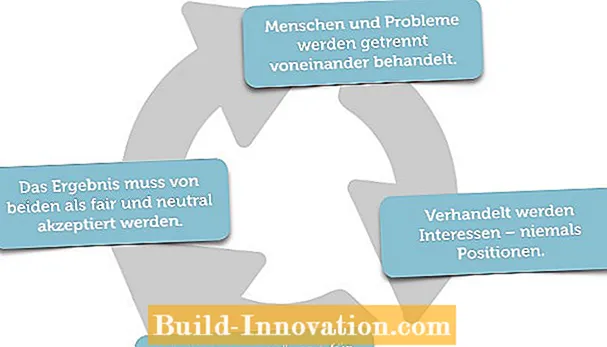Harvard concept: everyone negotiates for a profit

Content
- Negotiation training based on the Harvard concept
- People and problems are treated separately from one another
- Negotiate interests - not positions
- Develop options that are mutually beneficial (win-win)
- The result must be based on objective criteria
- Harvard Method: Demand versus Motive
- Harvard Concept: An Example
- Criticism of the Harvard concept: problem of asymmetrical information
- Harvard Concept: The Alternative
Hardly any other concept has influenced negotiation strategies more than in the past 20 years Win win - a lasting result, often based on compromises, that makes both parties happy. In the end, all are winners. The idea is based on the now legendary Harvard concept, which was actually developed at the university of the same name. And who doesn't want to leave a negotiation as a winner? With this trick you can even sell products, market services, even lay off employees: You find a new job that you are really good at - we meanwhile save costs. Win win…
Negotiation training based on the Harvard concept
The Harvard concept, also known by the name
- Harvard Principle
- Harvard approach
- or Harvard model
was developed in the early 1980s at Harvard University by the legal scholar Roger Fisher and is now part of the Harvard Law School standard repertoire. Bruce Patton later published a book of the same name together with Fischer and Ury Wiliam, which became a bestseller.
The Harvard method, as it is also called, is relatively simple at first glance and in parts of most people it is also unconscious applied in negotiations.
It consists of the four principles:
-
People and problems are treated separately from one another
Negotiations fail and conflicts escalate when the Factual level with the personal level is mixed and thus the emotions boil over. Surely some of us know that: While our counterpart makes a factual point in the negotiation and mentions certain facts, we take this as an insult or a personal attack. The result: an escalation of conflict.
It doesn't have to get that far if we are our counterpart as neutral as possible and would only consider a second party in solving the problem.
-
Negotiate interests - not positions
The difference between the two is really crucial. Anyone who as a party wants to achieve a good result in the negotiation must openly communicate their interests (more on this below).
If the interests of both parties are clarified, there is less potential for conflict and the The likelihood of an amicable settlement increases.
-
Develop options that are mutually beneficial (win-win)
When the two previous points have been clarified, you usually have a better idea of your own interests and, above all, of those of the other side - and that is important. It is easier to get in that way find an alternative approach.
What both negotiating partners need is a lot of creativity and flexibilityto come up with new solutions that can make decision-making easier.
-
The result must be based on objective criteria
The process doesn't just end with the stronger side providing the solution. Both sides must also make a decision objectively weighed against each other.
In this step it is important that both partners openly communicate their ideas and goals again. You can also use the feedback rules, for example, and ask your negotiating partner whether you have correctly understood his motives. If you're wrong, he has another chance to correct this.
So the last point means that both sides consider the basis for the later decision fair and neutral accept.

You may know about this Standard example:
Have two children share a cake. It would be fair and neutral: one child shares the cake and the other is allowed to choose his piece first. Nobody can complain about an unjust division - a classic win-win situation.

Harvard Method: Demand versus Motive
The core of the Harvard concept, however, are the first two points. They make sure that each Negotiation remains factualwhich has been shown to lead to better results. Quite a few people, however, start haggling and haggling at some point and get personal. And that rarely ends well.
An example: An employee wants to pay 500 euros more per month, but the boss only wants a maximum of 100 euros on top. Both sides climb here with one Extreme position and at best agree on a compromise. In doing so, they have to justify and defend their first position and attack and weaken the opposing position.
Effect: Both lose Time, strength and at the latest when compromising, your face, because both could not hold their original position. This is true even if the compromise was priced in from the outset by a completely exaggerated number.
Such specific demands are positions. You should never enter into negotiations with them. Because the basic problem of negotiations does not lie in opposing positions, but in the conflict of mutual needs, wishes, worries and fears Motifs. These, in turn, are interests and lie beneath the surface like an iceberg. Recognizing them is crucial because it is much easier to negotiate.
Harvard Concept: An Example
Let's look again at our salary example:
- The boss may have to go to work himself Save budget and therefore cannot pay much;
- the employee against it will soon have a child and I really want to react to the rising costs with a raise in salary.
Who can manage this silent motives to recognize in his counterpart and to make this the subject of the conversation negotiates more successfully:
- Psychologicallybecause he signals to the other that he takes him seriously and understands.
- Tacticalbecause he almost always asserts his own demands later when he first solves the other's problem.
In the mentioned salary example, the solution be that the employee waives an immediate salary increase and this is only firmly agreed for the new financial year. It is also conceivable that he will get a few days more vacation.
Very often negotiations failbecause both sides are only concerned with their positions and understand them as an either-or solution: Either I get it - or he. A zero-sum game.
Criticism of the Harvard concept: problem of asymmetrical information
The Harvard Method breaks this pattern of thought, but it also has its own Limits. Because it assumes what is seldom the case: Both sides have the same information and mean well to each other.
In the above example, if the employee knows that his company is doing brilliantly or that he is playing an important role for the store, the boss's reference to the tight budget will not work. On the contrary: the employee will exploited and lied to feel.
Science calls the problem asymmetric information - one side knows more than the other. In reality, this is almost always the case. So the one who knows more is always at an advantage. The result is a win-lose solution. Unless the other is very good will.
For you this means: The best result you will achieve this if you have mastered the Harvard concept, but do thorough research beforehand and get a head start on information.
Harvard Concept: The Alternative
Of course, even the Harvard concept does not always lead to the desired success - but the founders of the concept also have one for this case Alternative: BATNA. BATNA is an acronym made up of the following words: B.est A.alternative TO Negotiated A.greement, in German: The best alternative in the event of no agreement.
BATNA is there to provide your To strengthen the negotiating position. You think about which alternative you have in advance, in case you cannot find a compromise with your negotiating partner - and that is exactly what makes you go into the negotiation more optimistically and with more self-confidence.
In short, BATNA is yours Plan B for the negotiation - and more. If you clearly adhere to the guidelines that you made while preparing for the conversation with the other person, you will also know up to which point it is worth persevering.
When that point has come, get out of the negotiation and present your alternative.



